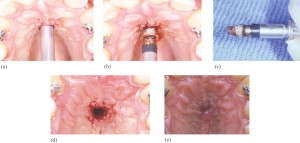Tongue thrust (also called reverse swallow or immature swallow) is the common name of orofacial muscular imbalance, a human behavioral pattern in which the tongue protrudes through the anterior incisors during swallowing, speech, and while the tongue is at rest. Nearly all young children exhibit a swallowing pattern involving tongue protrusion, but by the age of six most have switched to a normal swallowing pattern. People who tongue thrust do it naturally and are usually unaware of the behavior. Continue reading
Category Archives: Braces
Post operative instructions after placing braces
Eating first days
Although some patients are able to eat or drink almost anything while in braces and have no ill effects, there are certain dietary habits that are known to cause breakage of orthodontic appliances as well as increasing the risk of dental disease. Our aim is to achieve the treatment goals with as few disturbances due to appliance breakage as possible, and minimize the side effects of poor diet choices. Remember, teeth move their best in a healthy environment and in individuals with excellent overall health. Be sure you have a well balanced diet. Continue reading
Self ligating braces Part 3
Secure archwire engagement and low friction as a combination
Other bracket types—most notably Begg brackets—have achieved low friction by virtue of an extremely loose fit between a round archwire and a very narrow bracket, but this is at the cost of making full control of tooth position correspondingly more difficult. Some brackets with an edgewise slot have incorporated shoulders to distance the elastomeric from the archwire and, thus, reduce friction, but this type of design also produces reduced friction at the expense of reduced control. A deformable elastomeric ring cannot provide and sustain sufficient force to maintain the archwire fully in the slot without actively pressing on the archwire to an extent that increases friction. Continue reading
Self ligating braces Part 2
Advantages of self-ligating brackets
These advantages apply in principle to all self-ligating brackets, although the different makes vary in their ability to deliver these advantages consistently in practice:
more certain full archwire engagement;
low friction between bracket and archwire;
less chairside assistance;
faster archwire removal and ligation. Continue reading
Self ligating braces Part 1
Self-ligating brackets have an inbuilt metal labial face, which can be opened and closed. Brackets of this type have existed for a surprisingly long time in orthodontics— the Russell Lock edgewise attachment being described by Stolzenberg in 1935. Many designs have been patented, although only a minority have become commercially available. Self-ligating braces are defined as “a [dental] brace, which utilizes a permanently installed, moveable component to entrap the archwire”. Self-ligating braces may be classified into two categories: Passive and Active. Continue reading
Implantable devices as orthodontic anchorage Part 3
Palatal Implants
 One of the limitations of using implants for orthodontic anchorage is having adequate bone. Conventional root-form implants require adequate thickness of bone for placement, thus limiting their use to edentulous areas. Several authors have reported the midsagittal area of the hard palate as a suitable site for a short implant. Continue reading
One of the limitations of using implants for orthodontic anchorage is having adequate bone. Conventional root-form implants require adequate thickness of bone for placement, thus limiting their use to edentulous areas. Several authors have reported the midsagittal area of the hard palate as a suitable site for a short implant. Continue reading
Implantable divices as orthondontic anchorage Part 2
The high level of stability gained from the types of implants placed in retromolar or midpalatal regions is derived largely from the fact that the implants are osseointegrated. Initial concerns about disruption of osseointegration by orthodontic loading were proven to be unfounded by several studies. Continue reading
Implantable devices as orthodontic anchorage Part 1
Over the past 20 years dentistry has seen a dramatic increase in the use of dental implants. What was once an “experimental†or unproven treatment modality is now supported by an extensive research base. The vast majority of dental implant research is centered around the use of endosseous implants for replacement of missing teeth. Recently, the application of implants for use in other specialties has been explored. Previously, the use of dental implants within the specialty of orthodontics was limited to integration of implants into treatment plans strictly to facilitate tooth replacement. The orthodontic treatment that has traditionally been involved in treatment plans including dental implants has been limited to creating space or aligning roots for subsequent placement of implants. The use of dental implants as a direct adjunct to orthodontic treatment has been more limited until recently, but the potential exists for implants to play an important role in enhancing successful treatment outcomes. Continue reading
Spacing
Spaced dentition is characterized by interdental spaces and lack of contact points between the teeth. Spacing can be localized or generalized due to the number of teeth included. It is a common esthetic problem for many patients. A study in European adults showed that patients with broad midline spacing were perceived as being less socially successful and having lower intelligence. Continue reading
Crossbite
Crossbite is an occlusal irregularity where a tooth (or teeth) has a more buccal or lingual position (that is, the tooth is either closer to the cheek or to the tongue) than its corresponding antagonist tooth in the upper or lower arcade. Continue reading